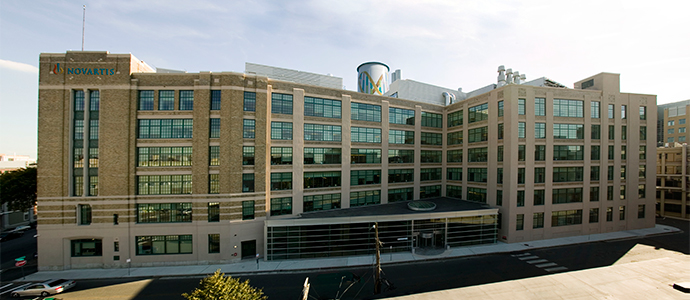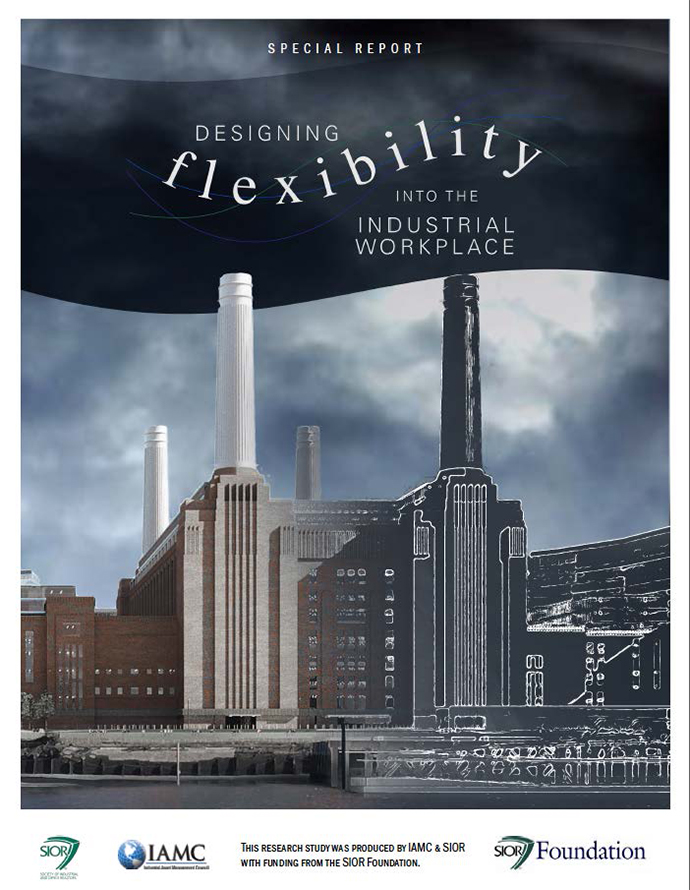A new white paper co-published by the Industrial Asset Management Council (IAMC) and the Society of Industrial and Office Realtors (SIOR) sheds light on re-using aging building stock and designing it for re-use in the first place. It also shines a light on the prominent leadership role of life sciences firms in doing so.
Funded by the SIOR Foundation, “Designing Flexibility Into the Industrial Workplace,”, authored by Ann Moline, contains some compelling survey insights.
In January 2013, IAMC and SIOR commissioned a survey of corporate users of industrial space to learn more about flexibility and adaptive re-use of industrial buildings. With 63 completed returns, the survey achieved a 37-percent response rate.
Among its primary findings:
- “A significant 84 percent of respondents indicate that flexibility and re-use potential are issues for them.” Industrial asset portfolios are aging: Nearly 80 percent of respondents said that their facilities — including warehouses, research sites, labs, and manufacturing plants — were on average at least 11 years old. More than 70 percent said their research facilities were 11 or more years old. Research facilities were the third most likely to be adapted and re-used, after warehouses and light manufacturing plants.
- “Even factoring in cost to decommission sites from earlier uses, there are cost savings in repurposing facilities compared to building out an empty shell.” Reusing existing infrastructure lowers the cost of the new build-out. More than 70 percent of respondents reported that the cost of stripping the building of unneeded, older equipment and infrastructure ranged between $4 and $25 per square foot, on average, “although these figures can vary depending on factors such as age of building, former use, and extent of specialty uses to be removed.”
- “Time to return on conversion investment is a critical consideration for corporate real estate portfolio managers.” When asked about ROI required to move ahead with a conversion project, more than 45 percent of respondents selected the one- to three-year time frame, while 29 percent said they would consider a three- to five-year time frame.
More than 80 percent of research conversion projects were completed in under two years, reports the white paper, with more than 50 percent taking between one and two years. For labs, 55 percent of respondents who did conversion projects said the process took one to two years, while about 36 percent estimated shorter time frames. “A variety of other time frames were reported as well: 17 percent of research conversions took three or more years while 9 percent of lab conversions extended beyond three years. Also of note: 40 percent of respondents said they had repurposed research facilities, and 39 percent re-used labs.”
Of the 13 survey respondents who said they had repurposed regulated manufacturing facilities (pharmaceutical and food), seven said that the average time to completion of such projects fell between one and two years. “Two respondents reported projects that averaged three years or more, while three said their projects took between six months and a year. One respondent reported an efficient, less-than-six-month completion time.”
Costs for conversion of lab or research space range from $150-250 per sq. ft. if the new use is as a classified facility (SCIF) to $200 per sq. ft. if the new use is office and as high as $400-750 per sq. ft. if the space is being upgraded for the same lab or research use. The range of original construction costs for lab and research facilities was between $250 and $350 per sq. ft., said survey respondents.
Respondents also said that specialty requirements associated with the new uses, such as installation of specialized infrastructure, represented a key cost factor when repurposing existing properties. And sometimes, these specialized requirements prevent users from re- using existing facilities. “We always start from scratch because our equipment and infrastructure is so specialized that it wouldn’t make sense to try to re-use something that’s there,” says one corporate owner. “Besides, the building itself is the least expensive aspect of our plant. The cost is in our infrastructure and equipment, and that wouldn’t be any different if we were using an existing facility or if we were doing something greenfield.”
Models Worth a Second Look
The report looks in on two projects from the life sciences sector. The first is the complete makeover of the former NECCO Wafer plant in Cambridge, Mass., built by the New England Confectionery Co. in 1926, into the research HQ for the Novartis Institutes for BioMedical Research.
“The $175 million Novartis project moved forward within a tight, two-year time frame and involved an unusual decommissioning process: removing sugar residue from the building’s floors and walls,” reports Moline. “It meant cleaning the old-school way — with bleach and hot water.”
But, as a company history of the facility documents, the signature water tower atop the building, fashioned to look like a roll of NECCO Wafers, was preserved. “The tower became an instant landmark on the Cambridge skyline and has become an important part of the city’s architectural fabric,” says the Novartis document.
Other notable adaptive re-use efforts include the conversion of the original power plant that had coal-fired boilers into a 20,000-sq.-ft. amenities building, which houses a 180-seat, fully-wired auditorium and a full-service cafeteria. Novartis also was awarded $850,000 in rebates for installation of energy-efficient equipment and materials including individually air-controlled fume hoods and high performance light fixtures.
Another look inside the life sciences comes from an unnamed biotech company, which chose to move forward with an open concept for its new lab/R&D complex, much to the chagrin of some of its scientists.
“Many of them consider themselves introverts by nature,” the firm’s facilities director told Moline, “so when we talked about working in open spaces, they got kind of nervous.”
The best solution ended up being a hybrid, mixing open areas with private nooks and crannies, and using Steelcase’s “Mediascape” furniture system, among other features, to create small, collaborative workspaces that can be moved as layout needs change. Utilities and services such as dishwashing are centralized and shared. A “freezer farm” features several commercial-grade freezers where samples can be stored at extremely cold temperatures, but smaller freezers are located near scientists’ individual workspaces for convenience.
“In addition to the workforce culture issues, fire code requirements, permitting, and the nature of the activities taking place all add to the complexity of the project,” says the white paper. “Work with solvents — a commonplace activity in a lab setting — comes with significant restrictions. ‘These activities have to remain anchored on the lower floors due to these restrictions, so that does constrain your flexibility,’ the director notes.” But he comes down on the side of a flexible future: “Designing for maximum flexibility will pay off in the long run,” he says.
An “Adaptability Checklist” in the white paper lists what to look out for by facility type. For lab and research properties, the list includes:
- Build in raised floors, movable partitions, and sink units that can be relocated.
- Reconfigure floor plan based on existing utility infrastructure.
- Centralize glass wash/freezer farms to free space.
- Add more services to modular utility grid, exhaust path, and process loops.
- Use “plug-and-play” technology infrastructure, pre-assembled testing and movable casework and equipment.
-
Going forward, a Phase 2 IAMC/SIOR study will identify scenarios for selected facility types that could dramatically increase their flexibility in use and reduce the time and investment needed to ready them for their next use


